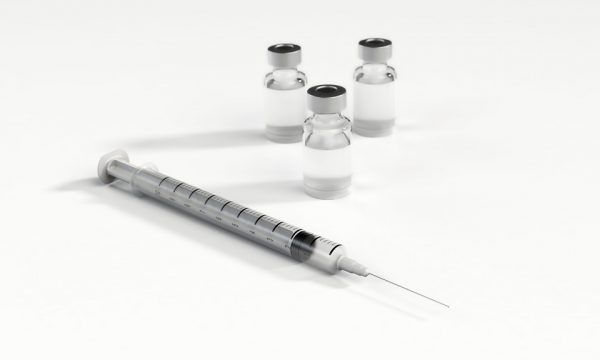Botulinum toxin (commonly called Botox, although that’s actually a specific brand) injections have been rising as a minimally invasive treatment for wrinkles. They’re quick, relatively painless and have almost no recovery time, and if you have an experienced injector the results look very natural. Since they stop muscle movement, botox injections can also be used to prevent future wrinkles.
I’ve personally had my face slimmed using botulinum toxin injections into my masseter muscles in the past.
Related Post: How Does Botox Work?
What is botulinum toxin resistance?
There’s an issue that’s become more glaring in recent times: botulinum toxin resistance. This is when your immune system recognises botulinum toxin, and deactivates it so it doesn’t work as well – you might need more to achieve the same effect, for example, or your muscles might still tense up after the botox injections.
This might not seem like a big issue if you’re only using botox for cosmetic reasons, but there are a lot of medical conditions where botulinum toxin injections are the first option for treatment. Dr Niamh Corduff, an Australian plastic surgeon who’s an expert in non-surgical rejuvenation and a Merz Aesthetics trainer, lists migraine, chronic pain, spasticity associated with stroke or cerebral palsy and drooling as some of these.

The alternatives to botulinum toxin? Sometimes these conditions can be treated with surgery, and sometimes with medications that aren’t as effective.
So if you’re thinking of getting botox injections for cosmetic reasons, it might be wise to consider decreasing the chances of developing botox resistance – that way, you’ll still have it available as a treatment option in case you develop a botox-treatable disorder in the future.
In one study, it was found that 13.9% of patients had developed antibodies against botulinum toxin after repeated therapy.
Avoiding resistance to botulinum toxin
One way to reduce resistance is to use a purer botulinum toxin product. Botulinum toxin is produced by bacteria, so it needs to be purified before use.
Different brands purify it in different ways – if unnecessary proteins remain in the product, they can act like adjuvants in a vaccine, which stimulate your immune system to have a bigger response. This makes resistance more likely.
The frequency of botox procedures also makes a difference. According to Dr Corduff, leaving more than 3 months between procedures helps.
The amount of botox used also affects the outcome. Using as little botox as possible will also reduce the chances of resistance.
How long does botulinum resistance take to fade?
If resistance does develop, it can fade away – but unfortunately it’s not a quick process. “Studies have shown that it can take 4 to 5 years for the antibodies responsible for resistance to drop after patients become resistant,” Dr Corduff says.
Can resistance to botulinum toxin be reversed or slowed?
Luckily, botox resistance can fade… but it takes time. A 4-5 year break from botulinum toxin treatments can be required, which can be an issue if it’s being used for medical problems. However, Dr Corduff says that patients that are starting to develop resistance can still be responsive to toxins with lower immunogenicity.
How can I check if my injector is looking out for resistance?
Dr Corduff recommends that you ask specifically if the toxin your injector is using is the best choice for reducing the chances of developing resistance.
References
Torres S et al., Neutralizing antibodies to botulinum neurotoxin type A in aesthetic medicine: five case reports (open access), Clin Cosmet Investig Dermatol. 2014, 7, 11-7. DOI: 10.2147/CCID.S51938
Albrecht P et al., High prevalence of neutralizing antibodies after long-term botulinum neurotoxin therapy, Neurology 2019, 92, e48-e54. DOI: 10.1212/WNL.0000000000006688
Frevert J et al., Comparison of botulinum neurotoxin type A formulations in Asia (open access), Clin Cosmet Investig Dermatol. 2018, 11, 327-331. DOI: 10.2147/CCID.S160723
Frevert J and Dressler D, Complexing proteins in botulinum toxin type A drugs: a help or a hindrance? (open access), Biologics 2010, 4, 325-32. DOI: 10.2147/BTT.S14902
Dr Niamh Corduff is a clinical trainer for Merz Australia. I was a guest at a Merz educational seminar on botulinum toxin resistance. This article is not intended to be a substitute for professional medical advice, diagnosis or treatment. For more information, see Site Policies.









What an interesting article!
About six years ago I became resistant to botox on my neck, but it still worked fine everywhere else on my face. I tried different types of botox, and different practitioners, but no luck. One practitioner noted that I had very strong neck muscles and wondered if this might be the cause.
I tried again about six months ago, but it still didn’t work.
Do you have any suggestions?
That is interesting, I never considered that this was possible – although it makes perfect sense. I never had Botox, be it for chemical or medical reasons, but still, good to know.
Anne from Doctor Anne
This is such an interesting article. I personally wouldn’t consider botox for cosmetic reasons because of my experience with Bell’s palsy. I found it unnerving not to be able to move any part of my face. Thank you for also pointing out the other uses of botox, as well as what those who get it should watch out for.